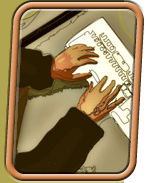|
|
||||||
|
|
|
|
||||
|
|
|
|
|
|
||
|
|
||||||
|
|
|
|
||||
|
|
|
|
||||
|
|
|
 |
|
|
|
|
|
|
|
|
|
|
|
|
|
|
|
|
|
|
|
|
|
|
|
|
|
The Soul of India The Wall Street Journal Asia Hyderabad is Sunita Achari's kind of town. On a recent Saturday night, the 25-year-old business analyst was meeting some friends for dinner — but she could just as easily have been dropping her newfound spending money on an evening at a trendy pub or the cinema. These days, the southern Indian city is "a very, very, very interesting place to live," she explained as she and a companion shopped for bangles. "It's rocking!" But the same Hyderabad that's home to swanky lounges with names like Touch is also one of the richest cities in India for Muslim history and tradition, where burqa-clad women mill about the 313-year-old Mecca Masjid, one of India's largest mosques. It offers the brand-conscious six-story City Center shopping mall, but also the bearded merchants selling the traditional sweetly scented itar (perfume). Indeed, Hyderabad appears equally comfortable wearing its renowned pearls or $30 distressed jeans from fashion outlet Globus. "My Hyderabad is developing," says 27-year-old Abdul Mateen Khan. "It's a megacity." It's also bouncing back from three deadly bombings last year. On May 18, an explosion at the Mecca Masjid killed nine people, and on Aug. 25, a pair of closely timed explosions killed 42 people in Lumbini Park and at Gokul Chat, a popular restaurant. Indian authorities linked the August blasts to groups in Bangladesh and Pakistan; those countries rejected the charges. But if the attackers' aim was to frighten Hyderabadis, they appear to have failed. Metal detectors have been installed at the bombed sites and elsewhere around the city, but Gokul Chat is still packed, and couples and families still come out to enjoy sunny days at the park and ride tour boats on nearby Hussain Sagar lake. And at Mecca Masjid, tourists have quintupled to 10,000 a day, says police constable Mahmood Ali. He acknowledges the number of Friday worshipers has dropped by half, but insists "there's not much tension." The area around the Charminar — the 416-year-old four-minaret monument near the Mecca Masjid — is nothing if not teeming, and salespeople in the adjacent Lad Bazaar do a brisk business in glass bangles and traditional clothing such as saris and sherwanis. Inside the 56-meter-high Charminar itself, locals and tourists alike jockey for a view of the metropolis founded by the Qutb Shahi dynasty in the late 16th century. "It's back to normal now," says information-technology retailer and art-gallery owner Prshant Lahoti. Lately nicknamed "Cyberabad" for its technology industry, the city arose thanks to a resource shortage at nearby Golconda Fort: Lacking water, the Qutb Shahis abandoned their citadel and built Hyderabad on the banks of the Musi River in 1591. The Mughal emperor Aurangzeb overthrew the Qutb Shahis in 1687, but Mughal rule was relatively short-lived: In 1724, viceroy Asaf Jah took control over Hyderabad, kicking off the age of the native sovereigns known as nizams. Hyderabad joined the Indian republic in 1948 and is India's sixth-largest city with more than six million inhabitants. Remains of Hyderabad's prerepublic glory can still be found in and around the city. Four kilometers west of town, ringed by three granite walls, Golconda Fort (also a former diamond storehouse) is a pleasant place to spend a few hours soaking up history — and breaking into a sweat on the long climb to the top. About one and a half kilometers from the fort is the sublime Indo-Persian architecture of the Qutb Shahi tombs, domed mausoleums housing graves of seven royals — one queen and six kings, including the Mecca Masjid's builder, Sultan Mohammed Qutb Shah. Bright green flags sporting the Islamic star and crescent drape some of them. For a visceral sense of the nizams' power and wealth, it may be best to visit the newly restored Chowmahalla Palace, whose construction originally began in 1750. Inside the Durbar Hall, with its distinctive Mughal domes and arches, sits a royal seat atop a marble platform. With its two courtyards and fountains and gardens spread out over five hectares, the palace complex is a tranquil respite from Hyderabad's crowded streets. A sign inside explains the palace was once accessible only to diplomats and royalty. In today's Hyderabad, as incomes rise and prosperity widens, it's increasingly the consumer who appears to be king. The new money can be seen in action at restaurants like Koyla, in Banjara Hills, where pretty young women in Paris Hilton-style sunglasses flank their beaus and wait for the help to fire up the hookah. At the six-year-old Kalakriti Art Gallery, a recent show featured stylish chairs by Hyderabadi artist Chippa Sudhakar for $2,300 apiece. Periodicals on sale at the Walden bookstore — inside aptly named Trendset Towers — included Upper Crust, "India's food, wine and style magazine." "I've seen so much change, even in the last 15 months," said 22-year-old U.K. transplant Helen Birkett, citing the mushrooming number of shops and bars. But for all its of-the-moment hipness and swagger, the enduring lure of Hyderabad is the old city, where jeweled bracelets sparkle in the sunshine and men and women whisper among themselves in the distinctive Urdu of the Deccan plateau. And it's most probably in the old city where, if you are lucky, you will encounter the likes of 56-year-old Gulam Mohsin-e-Azam, who will offer to buy you an orange soda while giving you a spot lesson on the Prophet Muhammad's teachings. "This world, this place is for little time," explains the skull-capped Mr. Mohsin-e-Azam. "Soul, we can't destroy. Forever it is." He could have said the same thing about Hyderabad.
|